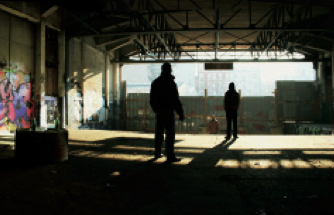Atelier Morales
The Steps, London
The Steps Gallery presented the first solo show in London of Atelier Morales, (Teresa Ayuso-1961, Havana; Juan Luis Morales-1960, Havana), Hermanos enemigos, their new digital photo-montage project. For this exhibition, they took into account the premises of the different strategies used to reinter- pret history’s myths and fables, and also the conflicts, violence and hostility between individuals or nations, which have been among the most recurrent horrors throughout the history of civilization. On this occasion, Atelier Morales re-created, by means of a series of middle-sized photographs, the myth that alludes to this particular issue, imbued with transcendent con- notations, through the appropriation of stories such as that of Cain and Abel, Romulus and Remus, Osiris and Seth, the con- flicts between Palestine and Israel, and among Catholics and Protestants in Northern Ireland.

Their careful research into profane and religious myths has allowed them to efficiently develop their proposal, charged with cultural, political and religious associations, and based on a formal refinement that confirms them as excellent artists. This is evidenced by the effects achieved through a baroque luminosity and by the quality of the composition, which joint- ly contribute to the creation of an atmosphere and to the icon- ic homogeneity conferred to their characters. With a polished control of the craft, they appropriate elements, personages and images from different moments in the history of art, as well as from contemporary conflicts. Each scene alludes to a double confinement: the one derived from the artwork’s habitual frame, and another that is materialized through a sort of win- dow created by the artists. In such environment, the subjects implied share the architectonic space proportionally with the elemenst around them, in order to freely interpret geographic, urban and social issues. Thus, their renderings are both famil- iar and strange, and in them fiction contaminates reality, and the trivial gives way to concern.
For the viewer, there are two superimposed levels of interpre- tation: the first level features the harshness of testimony, of the crude perception of the reality of facts, of the acknowl- edgement of situations that are sometimes unbearable, and of becoming aware of their existence. A second reading is associ- ated with the level of inexorable confrontation with facts, tran- scended through their dimension of timelessness. And in spite of Atelier Morales’s attempt to conciliate aesthetic and political commit- ment, and aesthetics with informa- tion, sometimes the aggressiveness of the photographic image disturbs the beholder’s perception.
Within the context of contemporary art, in which photography appears to be an increasingly central practice, the work of Atelier Morales is useful to remind us of its contradictory, yet always political and social character. Even so, it holds a space for reflection on such issues as violence, political activism, or the end of ideologies. The inclusion of certain “dramatic” ele- ments, such as the rereading and rein- terpretation of key moments in history, allows them to guide the viewer towards a more complex perception of their work, in which parody becomes a tool to reflect about the crueler and more dramatic factors of our reality. With “Hermanos enemigos,” they affirm their conviction that art can change the view that men have of themselves. It is a way of questioning the representations of civility.




